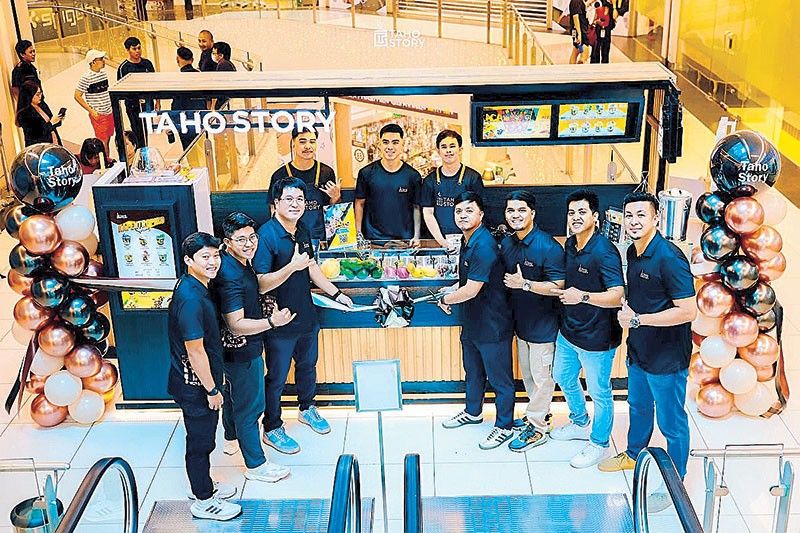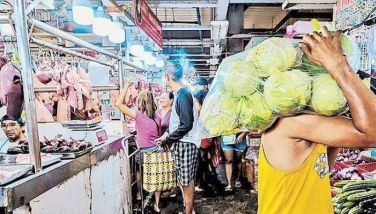Taho story: A hot-and-cold scoop of brewing success

MANILA, Philippines — All stories have a beginning. And for this up-and-coming food business, it all started with a sort of a “why not?” experiment.
It was at the tail end of the birthday celebration of Jude’s daughter at a buffet when his pal, Charlie, made a dessert of sorts.
Charlie scooped up some layers of soybean curd, locally known as taho. Added some arnibal or sugar syrup and the usual sago.
Next thing, he did the unimaginable. He asked for a few scoops of ube ice cream to be topped on his taho mix. It did not stop there. Charlie added some macapuno from the halo-halo section.
Voilà! An affogato of its own, just how Charlie describes it. Only that it was reversed: the hot component is added first before the cold one.
Charlie held up his dessert concoction, went to his pals, and told them with a grin: Bakit hindi?
Prologue: From balling to serving
It was March 1 when Charlie made taho with ice cream... and toppings. Weeks before that, Charlie, Jude and their gang have been wanting to put up a business. The only problem was, what type of business to invest in?
But Charlie’s dessert innovation paved the way for PHIBEsome Food Inc.’s business venture: taho with ice cream.
PHIBEsome traces its roots in the basketball rivalry among seven people: Jude Espinas, Charlie Hernandez, Paulo Perez, John Angelo Hernandez, Mico Inobaya, Edgar Palacio and Christian Bulalaque.
They used to play basketball against each other. Eventually, as they grew old, got jobs and had families, things changed. They became teammates.
They formed Team Bluey basketball, an organization envisioned to provide a platform to aspiring young Filipino ballers to compete at higher stakes. Filipino youth who do not have the opportunity yet to play in bigger leagues.
But joining leagues comes at a cost. To make the team sustainable, they thought of forming a business that would provide a stable source of income, not just for the team but also for themselves.
At first, five of the seven chipped in, hence the name of the corporation: PHIBEsome (fivesome). Eventually, the two others joined as well as the wife of Jude, making them eight, which they say, is considered lucky in Chinese culture since the number has been associated with wealth and fortune.
Chapter One: What’s in a name?
But what should they name the business? The friends listed more than 50 names, Jude said, but they cannot pick the right one.
Not until he asked his daughter’s insight about it. At that time, Jude’s kid, and namesake, was watching the animated film series Toy Story.
“She said Taho Story!” Jude told The STAR.
Lo and behold, they had an enterprise name.
“And it has an impact. Every time we go live on social media, we ask our customers what is your taho story? We want people to tell their beloved stories with taho,” Jude said.
Chapter Two: Hot or chilled taho?
Taho Story debuted in the market on April 29 with a physical store at Gyud Fud Market in University of the Philippines - Diliman.
The business started with eight flavors: the classic taho, avocado loco, ube de leche, la presas (strawberry), fruitas overload, banananut, oreoholic and mangga graham. Prices range from a P89 to P159, depending on the size, whether it is a medyo malaki or a malaki.
Taho Story wanted to target the active populace inside and within the vicinity of the UP Diliman campus since taho is a protein source.
Taho, or soybean curd, is mostly imported in the country since there is no substantial local production of the commodity. In fact, it is one of the country’s fastest growing imported agricultural goods.
This year, the country is projected to import 143,000 metric tons of soybeans, some of which would go to food use and that includes taho, according to an international unit of the US Department of Agriculture.
Taho Story sources its taho supply directly from vendors. The executives argue that they do this to ensure that the taho vendor would have guaranteed and stable income.
At first, the food business served only hot taho but eventually provided an option to consumers to opt for a chilled taho, which they said, have been more in demand than the former variety.
After a little over a month, another chapter unfolded: franchising. Taho Story wanted to open for franchising its business after setting up its first 10 company-owned stores. But things got accelerated because of the unexpected surge in demand for the product.
Chapter Three: 100 stores by year-end
Nearly three months in business, Taho Story would soon achieve opening up its 10 company-owned stores with the scheduled openings of its branches in the coming weeks across Metro Manila.
Taho Story is also expanding nationwide with at least 70 franchises set to open this year. Some of those would be in San Juan and Mandaluyong while others would be located in areas outside Metro Manila such as Roxas City, Tacloban, Quezon, Cebu, Ilocos, Iloilo and Zamboanga, among others.
“80 percent of the franchisees never tasted the product but they already signed the contracts for franchising,” Jude said.
This year, Taho Story plans to open a total of 100 stores nationwide. Franchising Taho Story costs P280,000 for medyo malaki, P350,000 for malaki and P480,000 for mas malaki packages.
Taho Story also serves additional eight coffee-infused flavors like mocha and biscoff worth P129 to P189 per cup, depending on the variety and size.
Taho Story credited social media for its sudden rise to popularity. From time to time, the people behind Taho Story go live on their social media accounts to engage with their customers and potential franchisees. They also do online raffles for their Facebook followers.
Epilogue: Bakit hindi?
Like in a basketball game, the quick turnaround of success for Taho Story feels like a fastbreak, Jude and his partners say. The food business is just turning a quarter old this week, but it has been able to make shots after shots of success.
But all these are part of a bigger story arc: to go global. Like other homegrown businesses, Taho Story wants a bite of the international market. Taho Story wants it done in five years. And the first step toward that chapter is opening its second physical store.
The firm opened its second branch for the year at Century City Mall of Antonio-family led Century Properties Group Inc. in Makati City. It was a strategic location, according to the executives.
“We wanted to showcase our product to the foreign market, and there are a lot of foreigners around here,” Jude said on the sidelines of the opening of their branch last July 13.
“What we want is to eventually export our products to the global market. There are a lot of overseas Filipino workers across the world. And that is a huge market to serve,” he added.
That day, they held a special promo for the first 100 customers: P1 for a cup of taho with ice cream and a chance to win P5,000. They served over 100 cups and a barber won the cash prize.
Just after the ribbon-cutting ceremony, the Taho Story executives celebrated in true basketball fashion: high fives and a huddle.
“Taho!” they cheered.
Perhaps, for Taho Story, their biggest chapter is yet to unfold.
“Our slogan is bakit hindi? because we believe in the potential of our product. It is straight out of tradition. The potential is limitless,” Jude said.
- Latest
- Trending




























